Ijraset Journal For Research in Applied Science and Engineering Technology
- Home / Ijraset
- On This Page
- Introduction
- Conclusion
- References
- Copyright
Project File in Circular Water Tank
Authors: Sushil Shah, Neeraj Kumar Jain
DOI Link: https://doi.org/10.22214/ijraset.2024.62980
Certificate: View Certificate
Abstract
Introduction
I. INTRODUCTION
A. Overview
Examining RCC circular subterranean water tanks provides a comprehensive understanding of these essential components of water distribution and storage systems. These subsurface tanks are designed to occupy as little space as possible while providing a stable water supply for a variety of uses, including industrial, firefighting, and residential. The cylindrical design of RCC Circular Underground Water Tanks confers various benefits. They can effectively distribute stresses and pressures because to their circular form, which makes them resistant to outside factors like soil pressure and possible earthquake loads. Additionally, by minimizing the possibility of corners or edges, this design lessens the likelihood of stress concentration areas that can result in structural flaws.
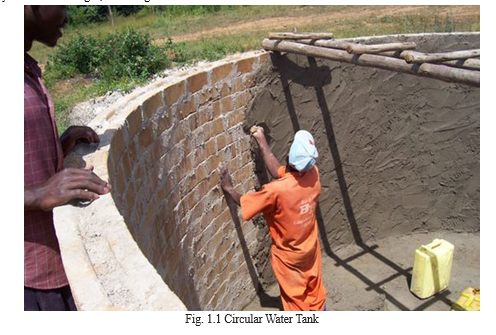
Consideration must be given to a number of variables during the construction of these tanks, including the state of the soil, the water table, and any potential environmental effects. Typically, reinforced concrete, a substance renowned for its strength and longevity, is used to build the tanks. Steel bars are used to reinforce the concrete walls, increasing their resistance to external and internal stresses. Ensuring watertightness and preventing leakage is a crucial component in the design and construction of RCC circular underground water tanks. Sufficient waterproofing techniques are necessary to safeguard the tank structure from potential water penetration damage and to preserve the safety and purity of the stored water.
- Need of Water Tank
The need for water tanks is driven by the imperative to secure and efficiently manage the supply of water for diverse societal requirements. These tanks serve as pivotal reservoirs, storing water for distribution to homes, industries, agriculture, and commercial establishments. This reservoir function becomes crucial during periods of water scarcity or high demand, ensuring a continuous and reliable water supply. Moreover, water tanks play an instrumental role in emergency preparedness, offering accessible water sources for firefighting, sanitation, and survival during disasters.
They also aid in managing fluctuating water demands by storing surplus water during low-demand periods and releasing it during peak times. Beyond ensuring consistent water delivery, elevated tanks help regulate water pressure within distribution systems, facilitating effective water use. Furthermore, water tanks contribute to water quality improvement through settling and treatment processes, ensuring the distribution of clean water. They serve both potable and non-potable water needs, supporting irrigation, industrial processes, and urban expansion. In remote or off-grid areas, water tanks become lifelines, providing localized access to water. By capturing rainwater and alternative sources, these tanks also foster sustainability and conservation efforts, making them indispensable components of modern infrastructure that address water security, basic needs, and urban growth challenges.
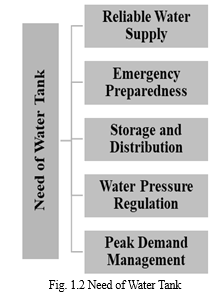
- Reliable Water Supply: Water tanks ensure a consistent supply of water even during periods of high demand, water scarcity, or emergencies, promoting overall water security.
- Emergency Preparedness: Water tanks serve as essential reservoirs for firefighting, disaster response, and sanitation during emergencies, contributing to community resilience.
- Storage and Distribution: They store and distribute water for various purposes, including domestic use, industrial processes, agriculture, and commercial activities, facilitating efficient water management.
- Water Pressure Regulation: Elevated tanks help maintain optimal water pressure in distribution systems, ensuring adequate flow and water accessibility to consumers.
- Peak Demand Management: Tanks store surplus water during low-demand periods and release it during peak consumption times, aiding in managing fluctuating water demands.
B. Reinforced Circular Water Tank
The water tank serves as a storage tank for water that can be used later on for irrigation, distribution, and firefighting. Depending on the needs, water can take on any size or shape. The circular water tank design is essential for the safe and cost-effective operation of tanks. Depending on its intended use, the water tank may be built above, below, or on the ground. The water tank's primary need is that it be waterproof. A water tank can be built using materials such as steel, RCC, masonry, or HDPE plastics.
1) Characteristics of RCC Circular Water Tank
Because circular water tanks have many properties with cylinders, the stress distribution on these tanks also resembles cylinder characteristics. Because the stress is distributed symmetrically with rotation, the stress distribution is unaffected by rotation of the tank about a fixed axis.


Axial Stress: Parallel to the cylinder's axis, axial stress emerges. It arises due to the load applied along the cylinder's length, which can be the weight of the stored water and any other vertical loads. Axial stress acts to elongate or compress the cylinder, depending on the direction of the load.
Radial Stress: Perpendicular to the symmetry axis of the cylinder, radial stress forms. This stress pattern exists within the same plane as the circular cross-section. Radial stress is responsible for distributing the load across the tank's walls, ensuring structural stability.
Collectively, these stress patterns—hoop stress, axial stress, and radial stress—interact to maintain the integrity and strength of circular water tanks. The ability to distribute stress symmetrically and account for various load directions is crucial for designing robust and reliable water storage structures.
C. Importance of Seismic Resilience in Water Tank Design
Seismic resilience emerges as a paramount consideration in the design of water tanks, particularly in regions prone to seismic activity, where the looming potential of earthquakes poses a formidable threat to both structural stability and overall infrastructure. The significance of infusing seismic resilience into water tank design cannot be overstated, as it exerts a direct influence on the fundamental pillars of safety, operational functionality, and the enduring lifespan of these vital structures. This comprehensive elucidation delves into the profound implications of seismic resilience within the context of water tank design:
- Ensuring Structural Integrity and Safeguarding Safety
Seismic occurrences, such as earthquakes, subject structures to dynamic forces and ground vibrations of unprecedented magnitudes. Within this seismic realm, water tanks stand as a critical component that must exhibit unwavering resilience. The pivotal objective is to ensure these tanks can withstand seismic forces without succumbing to catastrophic collapse or experiencing severe structural impairments. Seismic resilience functions as a bulwark, guarding against potential failure scenarios that could lead to dire consequences, including water contamination, loss of human life, and substantial property damage.
2. Uninterrupted Continuation of Water Supply
The intrinsic value of water tanks is magnified during emergencies, particularly seismic events that disrupt the normal course of life. Seismic resilience bears the imperative of allowing water tanks to maintain operational functionality even in the aftermath of an earthquake. This capability ensures that these reservoirs can continue storing and dispensing water, thereby becoming a linchpin for emergency response strategies, firefighting efforts, and the sustenance of essential services during tumultuous times.
3. Mitigating Business Disruptions
Industries that heavily rely on a stable water supply, such as manufacturing and agriculture, face dire financial repercussions in the event of water scarcity. Seismic resilience emerges as a shield against such disruptions, minimizing the risk of water tank damage. This, in turn, culminates in reduced business interruptions, mitigating economic losses and their subsequent cascading impacts.
4. Empowering Community Resilience
Water tanks bear a pivotal role in bolstering community resilience during and after seismic events. The strategic integration of seismic resilience within tank design equips communities to navigate disasters more effectively, ensuring consistent access to clean drinking water, sanitation facilities, and firefighting resources. This communal preparedness elevates the overall capacity to withstand and recover from seismic shocks.
5. Promoting Long-Term Economical Viability
Incorporating seismic resilience measures at the design stage may necessitate additional investment; however, this upfront commitment leads to substantial long-term cost savings. A water tank that is well-conceived and engineered to withstand earthquakes necessitates fewer reparations and replacements over its operational lifespan, thus mitigating maintenance costs and optimizing economic efficiency.
6. Adhering to Regulatory Frameworks
Many regions mandate the adherence of critical structures, including water tanks, to stringent building codes and regulations that prioritize earthquake-resistant design. By imbuing water tank designs with seismic resilience, designers and engineers ensure compliance with these standards, avert potential legal entanglements, and circumvent regulatory complexities.
7. Safeguarding Public Health
Seismic resilience also plays a pivotal role in maintaining public health. Ensuring that water tanks remain structurally sound and functional following an earthquake prevents contamination and the onset of waterborne diseases. The catastrophic consequences of compromised water storage underscore the urgency of designing tanks that uphold the integrity of water supply, thereby safeguarding public health and well-being.
8. Expediting Post-Earthquake Recovery
Rapid recovery is imperative in the aftermath of an earthquake to restore normalcy swiftly. Water tanks engineered with seismic resilience can swiftly resume their functions, expediting recovery and reconstruction efforts by providing a critical resource for rehabilitation endeavours.
9. Mitigating Secondary Hazards
Earthquakes can trigger secondary hazards like landslides and tsunamis, magnifying the potential devastation. Integrating seismic resilience into water tank design minimizes the risk of instigating or exacerbating such secondary hazards, thereby fostering a safer environment and contributing to comprehensive disaster risk reduction strategies.
10. Driving Engineering Advancements
The pursuit of seismic resilience in water tank design propels advancements in engineering and technology. Engineers and researchers endeavor to develop innovative solutions that effectively mitigate seismic impacts, thereby contributing to the broader advancement of earthquake-resistant infrastructure. This collaborative endeavor catalyzes the evolution of engineering knowledge and solutions, strengthening the global resilience against seismic events.
D. Overview of Seismic Zoning and Impact on Structural Design
- Seismic Zoning
Seismic zoning, also known as earthquake zoning, refers to the division of a geographical area into different zones based on the potential for seismic activity and the expected intensity of earthquakes. This zoning is determined by evaluating historical seismic data, geological characteristics, tectonic plate movements, and other geological and seismological factors. The purpose of seismic zoning is to categorize areas according to their level of vulnerability to earthquakes, helping engineers, architects, and policymakers make informed decisions about construction practices, building codes, and infrastructure development to ensure safety and minimize the impact of seismic events.
Seismic zones are typically categorized numerically, with higher numbers indicating higher levels of seismic activity and potential ground shaking. The specific criteria used to determine these zones vary from one country or region to another. The zones are generally defined based on factors such as:
- Historical Seismic Activity: The frequency and magnitude of past earthquakes in the area provide insight into the potential for future seismic events.
- Tectonic Plate Boundaries: Areas near tectonic plate boundaries are more likely to experience significant seismic activity due to the movement and interaction of Earth's crustal plates.
- Fault Lines: The presence of active fault lines indicates areas where earthquakes are more likely to occur. These faults can produce strong ground shaking when they rupture.
- Geological Conditions: The type of soil and rock present in an area can influence how seismic waves travel and affect structures.
- Geographical Features: Mountain ranges, valleys, and other geological features can impact the distribution of seismic forces.
- Seismic Hazard Assessments: Seismologists and geologists use sophisticated models to predict the potential ground shaking and intensity of earthquakes in different areas.
Once seismic zones are established, they serve as the basis for developing building codes and regulations. Structures in higher seismic zones must adhere to more stringent design standards to ensure they can withstand the forces exerted by earthquakes. This might involve using specific construction techniques, materials, and engineering strategies to enhance the structure's seismic resilience. Seismic zoning plays a vital role in ensuring the safety and resilience of buildings, infrastructure, and communities in earthquake-prone regions. By understanding the seismic risk associated with a particular area, stakeholders can make informed decisions that contribute to the overall preparedness and mitigation of seismic hazards.
2. Impact on Structural Design
Seismic zoning has an important impact on structural design and is a crucial variable in determining the resilience and safety of infrastructure and buildings in earthquake-prone areas. The design, building, and retrofitting of structures to make sure they can survive the forces produced by earthquakes are all directly impacted by seismic zoning. The following are some ways that seismic zoning influences structural design.
- Building Codes and Regulations: Seismic zones are fundamental in shaping building codes, ensuring structures can withstand earthquakes. Each zone has specific criteria dictating load-bearing capacities, material specifications, and design methodologies. These regulations aim to fortify buildings against seismic activity, enhancing overall safety in earthquake-prone areas. Adaptation to evolving seismic knowledge is crucial for continuous improvement in construction practices.
- Design Criteria: The level of seismic risk in a particular zone dictates the seismic design parameters for structures. Design criteria include factors like the maximum allowable lateral displacement, base shear forces, and other load combinations that structures must be designed to withstand.
- Structural Loadings: The seismic zone influences the magnitude of seismic forces that structures must be designed to resist. Structures in higher seismic zones are subjected to more intense ground shaking, resulting in greater forces acting on them. Structural engineers use these forces to calculate design loads and ensure the stability of the building.
- Construction Materials: The choice of construction materials, such as concrete, steel, or wood, is influenced by the seismic zone. Certain materials offer better ductility and flexibility, making them suitable for regions with higher seismic risk. Structural engineers select materials that can withstand the forces associated with the seismic activity expected in the zone.
- Design Methodologies: Different seismic zones require different design methodologies to ensure structural integrity. Engineers consider factors such as the behavior of materials under cyclic loading, energy dissipation, and the potential for brittle failure. Designers in higher seismic zones often incorporate techniques such as base isolation and energy-absorbing devices to enhance a structure's seismic resilience.
- Foundations and Footings: Seismic zones impact the design of foundations and footings to ensure stability during ground shaking. Engineers must account for factors like soil type, liquefaction potential, and the likelihood of landslides when designing foundations to resist seismic forces.
- Retrofitting Existing Structures: Seismic zoning also affects the retrofitting of existing structures to meet modern seismic standards. Buildings constructed before the implementation of current seismic codes may need to be retrofitted to improve their earthquake resistance, especially if they are located in higher seismic zones.
- Risk Assessment: The understanding of seismic zoning allows engineers to assess the risk associated with specific structures. It helps identify vulnerable areas and structures that might require additional attention or modifications to ensure their safety.
E. Circular Water Tanks and Their Structural Considerations
Circular water tanks are cylindrical structures designed to store and distribute water for various purposes, such as domestic, industrial, and firefighting needs. Their distinct shape provides several structural advantages, making them a popular choice in water storage systems. Here's an overview of circular water tanks and the key structural considerations associated with their design:
- Shape and Properties
Circular water tanks are characterized by their cylindrical shape, which offers inherent structural stability. The symmetrical design ensures uniform distribution of forces and stresses, contributing to enhanced load-bearing capacity and resilience against external pressures.
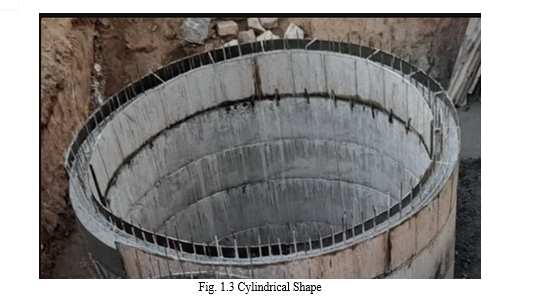
2. Structural Considerations
Designing circular water tanks involves several critical considerations to ensure their structural integrity, durability, and operational efficiency:
Material Selection: The choice of construction material, such as reinforced concrete or steel, is essential in determining the tank's strength and durability. Engineers consider factors like corrosion resistance, cost-effectiveness, and the tank's intended service life.
Foundation Design: Proper foundation design is crucial to distribute the tank's weight evenly and prevent settlement. Soil characteristics, bearing capacity, and potential for settlement under varying loads are assessed to ensure stable support.
Hydraulic Loadings: Circular tanks experience hydraulic loads due to the weight of stored water, which can be substantial. Engineers must calculate the hydrostatic pressure and ensure that the tank walls, base, and foundation can withstand these loads without deformation or failure.
Seismic Resilience: Circular water tanks located in earthquake-prone regions must be designed to withstand seismic forces. Engineers analyze the tank's response to ground motion, considering factors like the seismic zone, soil conditions, and potential ground acceleration.
Wind Loads: Circular tanks are exposed to wind forces, especially when located in open areas. Engineers evaluate wind speed, local topography, and building height to calculate wind loads and ensure structural stability.
Stress Distribution: The cylindrical shape of these tanks results in consistent stress distribution along the wall and base. Engineers analyze hoop stress (circumferential stress), axial stress (parallel to the tank's axis), and radial stress (perpendicular to the symmetry axis) to ensure they remain within safe limits.
Design Codes and Standards: Circular water tanks must adhere to relevant design codes and standards that govern construction practices, material specifications, and safety factors. Codes like IS 3370 (Part II) and IS 456 provide guidelines for designing water-retaining structures.
Waterproofing: To prevent leakage and maintain water quality, proper waterproofing methods are crucial. Engineers must ensure that the tank's walls and base are effectively sealed to prevent water infiltration and potential structural damage.
Accessories and Appurtenances: Design considerations also extend to tank accessories and appurtenances, such as inlets, outlets, valves, and overflow provisions, which must be integrated into the tank's design without compromising its structural integrity.
F. Significance of Seismic Analysis and Design
Seismic analysis and design hold immense significance in the realm of civil and structural engineering, particularly in regions prone to earthquakes. The process involves assessing the potential impact of seismic forces on structures and designing them to withstand these forces. The significance of seismic analysis and design can be understood through several key points:
Safety of Structures and Lives: The primary goal of seismic analysis and design is to ensure the safety of structures and the people who inhabit or use them. Earthquakes can exert tremendous forces on buildings, bridges, dams, and other infrastructure, leading to catastrophic failures if not properly accounted for in design. Seismic-resistant structures can minimize the risk of collapse and prevent loss of life during earthquakes.
Protection of Property: Beyond human safety, seismic analysis and design also protect property and assets. Buildings, facilities, and infrastructure represent substantial investments, and their failure during an earthquake can result in significant financial losses. Proper seismic design helps minimize damage, repair costs, and business interruptions.
Resilience of Infrastructure: Seismic analysis and design contribute to the resilience of infrastructure. By considering seismic forces, engineers create structures that can withstand the impact of earthquakes and continue to function afterward. This is especially crucial for critical facilities like hospitals, emergency response centers, and water supply systems that need to remain operational during and after disasters.
Legal and Regulatory Compliance: Many regions have building codes and regulations that mandate seismic-resistant design for certain structures. Compliance with these regulations is not only a legal requirement but also ensures that structures are designed to withstand the potential seismic forces in the area, reducing vulnerability and liability.
Long-Term Durability: Seismic analysis and design also contribute to the long-term durability of structures. By accounting for seismic forces, engineers prevent premature wear and tear, ensuring that structures remain functional and safe for extended periods. This longevity reduces the need for frequent repairs and replacements.
II. LITERATURE REVIEW
Z Yang et. al. [1] In this research, the focus is on exploring how various shapes of water tanks influence their ability to store thermal energy and maintain thermal stratification under static, laminar, and naturally convective conditions. A novel experimental setup has been designed and implemented alongside a computational model to examine the patterns of heat transfer and fluid dynamics inside these tanks.
The findings from the computational simulations are found to be in strong agreement with the experimental observations. Among the ten water tank shapes analyzed, spherical and barrel-shaped tanks exhibit optimal thermal energy storage capacities, while cylindrical tanks are least favorable. The storage capacity is closely tied to the tank's surface area. Based on velocity and temperature field characteristics, the shapes are categorized into three groups: those with sharp corners, hemispherical shapes, and horizontal plane surfaces. Sharp-cornered shapes show the highest degree of thermal stratification, while horizontal plane surfaces exhibit the lowest.
Hemispherical shapes lie in between. The thermal stratification patterns are influenced by the flow at the tank's bottom and heat transfer to the environment.
AE Kabeel et. al. [2] This study focuses on enhancing the performance of pyramid solar stills through additional components. Circular copper fins and a phase change material (PCM) tank are integrated into the conventional pyramid solar still design to prolong water production after sunset. Comparative experiments are conducted on three setups: conventional pyramid solar still, pyramid solar still with hollow circular fins, and pyramid solar still with fins and PCM. The results reveal that the utilization of hollow circular fins increases daily productivity by 43%, while adding PCM further enhances it by 101.5%. The modified pyramid solar still outperforms previous designs in terms of productivity and efficiency.
H Huang et. al. [3] This paper proposes a system combining phase change material (PCM) thermal storage with a water tank for solar heating systems. The system's configuration and a composite PCM are investigated for their impact on efficiency. A system model is developed using TRNSYS software, and a numerical calculation program is compiled to account for supercooling in the PCM unit. The study identifies optimal PCM parameters through simulations, ultimately selecting sodium acetate trihydrate mixtures as the PCM. The combined use of the PCM unit and water tank improves the heat storage system's efficiency, increasing the solar fraction by around 30% compared to a single water tank system. Furthermore, the series system demonstrates a 5%-12% enhancement in solar fraction compared to a parallel water tank-PCM unit system.
A Dahash et. al. [4] Large-scale seasonal thermal energy storage (TES) is a promising component in future renewable-based district heating systems. Simulation-driven assessments are crucial to design and plan such systems efficiently. This work reviews the development and validation of numerical models for advanced TES applications, considering multi-physical aspects and dynamic energy flows.
MY Abdelsalam et. al. [5] A numerical model is developed to simulate the performance of sensible and hybrid energy storage integrated into solar domestic hot water systems. The study explores direct and indirect heat exchange configurations. Comparisons based on solar fraction, indicating solar thermal energy contribution to the load, are made between both systems. Direct heat exchange systems exhibit larger solar fractions, and adding phase change material modules to the water tank can reduce storage volume by 40%. The choice of PCM melting temperature is vital for optimal energy storage in the latent form and temperature stability.
ST Summerfelt et. al. [6] This study involves a comprehensive survey conducted to investigate the characteristics of large circular or octagonal culture tanks used in the production of Atlantic salmon smolt and post-smolt by major Norwegian salmon production companies. The survey covers various aspects, including tank geometry, operating parameters, and other key features. The research focuses on both land-based hatchery locations and sea-based tanks. The results reveal that a total of 55 large tanks were reported at seven land-based sites, averaging around 7.9 tanks per site. The culture volume of these tanks ranged from 500 to 1300 m3, and they exhibited diverse dimensions and flow rates. The study highlights trends such as tank diameters, maximum depths, flow rates, hydraulic retention times, and feed loads, providing insights into the evolution of tank designs and their operational aspects.
M Shan et. al. [7] The pursuit of energy efficiency has led to the promotion of solar energy heating systems in China. This study presents the development and testing of a comprehensive space heating system, which integrates passive sunspace, active solar water heating, and an air-source heat pump (ASHP). This system was specifically designed and evaluated for its performance in a cold climate region, aiming to address the common issues associated with such environments. This study analyzes the performance of each subsystem within this integrated system and evaluates its efficiency in maintaining a stable indoor thermal environment during winter. Notably, the integrated system showed promising results in terms of energy consumption and thermal comfort. However, the study also identified certain limitations and proposed recommendations to optimize the system's performance. The research emphasizes the potential of such integrated systems for energy savings and emission reductions in rural buildings, contributing to broader energy targets.
C Makropoulos et. al. [8] The escalating issue of water scarcity due to urbanization and climate variability has prompted societies to explore water reuse as a solution. This paper delves into the ongoing discourse between centralized and decentralized water reuse methods, considering efficiency and economic viability. The concept of 'sewer-mining' emerges as an intermediate scale water reuse option, demonstrating potential benefits in problematic wastewater treatment plant locations and involving Small Medium Enterprises (SME) in the water market. The study presents a pilot sewer-mining application in Athens, Greece, integrating treatment technologies and an information and communications technology (ICT) infrastructure. The results highlight the performance of the pilot and underline the potential of sewer-mining as a significant component of the circular economy for water.
K Shubhangi et. al. [9] The profound significance of water is evident from the historical settlements around water sources, often characterized by architectural marvels such as step wells. This paper focuses on the exemplary step wells found in the region of Chanderi town, Madhya Pradesh, India. These step wells, dating back several centuries, continue to serve their original purpose of water collection and storage. The paper emphasizes the architectural and aesthetic significance of these structures, highlighting their cultural, functional, and recreational value. The unique relationship between water and architectural typologies is showcased through the examples from Chanderi, showcasing the remarkable contributions of Indian Water Architecture.
H Yuk et. al. [10] Sea animals like leptocephali possess transparent hydrogels in their tissues, allowing for agile movement and natural camouflage underwater. This study introduces hydrogel-based actuators inspired by leptocephali, capable of high-speed, high-force actions, and optical and sonic camouflage in water. Unlike existing osmotic-driven hydrogel actuators, these hydraulic actuators exhibit exceptional performance and robustness, even maintaining functionality over multiple actuation cycles. The study presents innovative applications of these agile and transparent hydrogel actuators, showcasing their capabilities in swimming, interacting with objects, and even catching live fish underwater. This research demonstrates the potential of these hydrogel actuators for diverse fields.
W He et. al. [11] presents a comprehensive investigation into a novel heat pump assisted solar façade loop-heat-pipe (LHP) water heating system, combining both theoretical and experimental approaches. The study encompasses various stages: (1) development of a computer numerical model, (2) simulation of the system's operational performance using the model, (3) construction of a test rig, and (4) dedicated experiments to validate the model's accuracy. The results demonstrate that the established numerical model accurately predicts the system's operational performance. Analyses of the research findings reveal that, under the specific testing conditions, the LHP module exhibits an average thermal efficiency of approximately 71%, a considerable improvement compared to the loop heat pipe without heat pump assistance. The efficiency of the LHP module increases when the heat pump is activated and decreases when deactivated.
The water temperature displays a consistent upward trend during the heat pump's operation. Considering the heat loss of the water tank, the highest coefficient of performance reaches a remarkable value of 6.14, with an average value of around 4.93. Overall, the system introduces a new façade integrated solar water heating configuration that is both highly efficient and visually appealing. Implementing this system on a larger scale could contribute to reduced fossil fuel consumption and carbon emissions in the building sector.
Z He et. al. [12] delves into the heat transfer and flow resistance characteristics within a vertical heat exchanger, utilizing a combination of helical baffles and elliptic tubes. The research investigates the behavior of a non-Newtonian fluid, specifically an aqueous solution with 3% weight fraction of carboxymethyl cellulose, flowing through the shell side of the heat exchanger. The performance of the heat exchanger using elliptic tubes is compared to a similar setup with circular tubes. Numerical analysis reveals that the elliptic tubes exhibit enhanced heat transfer rates and shell side Nusselt numbers, along with reduced shell side friction factors. The overall thermal performance factor demonstrates a 30-35% improvement, indicating the efficiency of elliptic tubes in improving heat transfer in non-Newtonian fluid flow. Experimental results contribute to the development of correlations predicting Nusselt number and friction factor for the heat exchanger with helical baffles and elliptic tubes.
J Yan et. al. [13] examines subcooled flow boiling, particularly under conditions of high heat and mass flux, a scenario common in fields like nuclear power engineering. It zeroes in on the heat transfer processes of water undergoing subcooled flow boiling inside a vertical circular tube, under these intense conditions. Through experimental methods, the study investigates the heat transfer coefficients associated with various flow regimes. Experimental investigations explore heat transfer coefficients across different flow regimes. Parameters such as mass flux, heat flux, system pressure, and thermodynamic vapor quality are varied to observe their effects. The research assesses various heat transfer correlations available in the literature against experimental data and proposes a modified Chen correlation that provides accurate predictions with minimal errors. Additionally, a modified Lahey model is introduced to analyze the contribution of nucleate boiling to the total heat transfer coefficient under the specified conditions.
TH New et. al. [14] investigates the flow dynamics resulting from a laminar circular jet impinging upon a convex cylinder. Employing laser-induced fluorescence and digital particle image velocimetry techniques, the research examines cylinder-to-jet diameter ratios of 1, 2, and 4. The flow visualization and analysis reveal the behavior of ring-vortices generated by the impingement, their movement around the cylindrical surface, and the effects of cylinder diameter on boundary layer separation, vortex dipole formation, and wake size. The research quantifies wall shear stress distribution and presents a three-dimensional flow dynamics model to explain the observed phenomena.
DR Plew et. al. [15] explores the influence of juvenile Atlantic salmon on flow and turbulence within a circular tank. Different fish sizes and stocking densities were considered, and their impact on water velocity, turbulent kinetic energy, turbulence intensity, and turbulence dissipation rates were measured. Additionally, dissolved oxygen levels were assessed, and turbulent transport of oxygen was calculated. The presence of fish led to alterations in flow patterns, turbulence characteristics, and oxygen distribution within the tank. The research provides insights into the interplay between fish behavior and flow dynamics, shedding light on the interactions between aquatic life and fluid motion.
T Arunkumar et. al. [16] introduces an innovative compound parabolic concentrator (CPC)-concentric circular tubular solar still (CCTSS) that incorporates phase change material (PCM). The study involved experimental tests with the CCTSS, both with and without PCM. In the experiments, a circular trough within the tubular solar still was filled with 450 grams of paraffin wax per tube, serving as the PCM. Key parameters such as the water temperature (Tw), air temperature (Tair), outer cover temperature (Toc), and the production of fresh water were monitored at regular intervals. The findings of the study highlight the performance of the CPC-CCTSS system when integrated with PCM exhibited a fresh water production of 5779 ml/m2/day, whereas the system without PCM yielded 5330 ml/m2/day. Consequently, PCM integration led to an 8% enhancement in fresh water productivity.
R Bhadouriya et. al. [17] experimental study delved into the heat transfer and friction factor characteristics of airflow within an annular space created by a twisted square duct inside an outer circular pipe. The research covered a wide Reynolds number range from 400 to 60,000, utilizing air as the working fluid and maintaining a uniform wall temperature at the inner surface of the annulus. Various twist ratios were tested and compared against a standard straight square duct in a circular pipe setup. The findings indicated notable enhancements in both heat transfer efficiency and pressure drop in both laminar and turbulent flow conditions. The study also examined how the annulus design influences the friction factor and heat transfer, resulting in the development of empirical correlations for these factors across laminar and turbulent flow regimes. The study also included a numerical analysis to extend the results to a wider range of fluid parameters.
M Abdelgaied et. al. [18] aimed to enhance the performance of a tubular solar still through additional design features. Copper hollow fins were added to the absorber surface, and a phase change material (PCM) reservoir was placed beneath the absorber to extend water production time after sunset. Two experimental scenarios were investigated: one involving different shapes of copper hollow fins and the other incorporating both hollow circular fins and PCM. Results revealed that the utilization of hollow square and hollow circular fins improved productivity by 33% and 47.2% respectively, while combining hollow circular fins with PCM increased productivity by 90.1%. Comparisons with previous studies demonstrated the efficacy of these modifications in enhancing the performance of the tubular solar still.
SC White et. al. [19] Investigated the implementation of hanging plastic conduit segments as a form of environmental enrichment in spacious circular tanks used for rearing Brown Trout and Rainbow Trout. The tanks were either void of structure or enriched with a suspended array of plastic conduit sections. Results demonstrated improved tank weight gain and feed conversion ratio for both species in enriched tanks. The use of suspended enrichment did not significantly affect individual fish size or condition factor. The enrichment structures did not interfere with tank hydraulic self-cleaning. The research suggests that vertically suspended enrichment structures can enhance trout rearing efficiencies in circular tanks.
T Bouhal et. al. [20] aimed to assess thermal stratification within a standard hot water storage tank, specifically in the context of solar water heaters. Different flat plates with varying titled positions were incorporated into a vertical tank prototype. Computational fluid dynamics (CFD) simulations were performed to analyze the impact of flat plate positions on thermal stratification during the charging mode. Parameters such as temperature evolution, Richardson number, and stratification number were calculated. The study found that the thermal stratification within the storage tank depended on the flat plate positions. Increasing the number of flat plates in different positions did not necessarily result in suitable thermal stratification. Superior thermal performance was achieved when a flat plate was positioned at the middle height of the storage tank. Moreover, integrating flat plates at different angles contributed to the development of the thermocline structure.
S Rizzo et. al. [21] The foundation of achieving waste management and prevention goals set forth by the European Waste Framework Directive 2008/98/CE and the Circular Economy Package lies in increasing awareness about the impact of our actions. Circular Economy is closely tied to advancements in manufacturing technologies and the promotion of responsible consumption and waste reduction. Universities, as educational and institutional entities, offer a platform not only to transform our technological systems through eco-innovation but also to reshape societal values with a focus on sustainability. Universities play a crucial role in fostering interdisciplinary and transdisciplinary approaches that generate knowledge in the field of sustainability. The Terracini in Transizione living lab of sustainability, situated within the School of Engineering and Architecture at the University of Bologna, exemplifies this approach. It not only enriches research and teaching but also engages engineering students. Through this living lab, collaborative efforts between students, researchers, and professors have led to the co-design of experimental green technologies for Urban Resilience. Notably, some of these solutions incorporate recycled materials, closing the loop on material utilization. This study specifically investigates the water and rooting capacity of innovative recycled materials as substrates for cultivating edible plants in advanced green technologies such as soilless cultivation. The experiment includes a range of substrates, both traditional and recycled, and aims to contribute to the sustainable development of urban agricultural systems.
Z Wei et. al. [22] Experimental investigations have been conducted to understand the water entry behaviors of three-dimensional circular cylinders at low Froude numbers. While a previous paper focused on horizontal circular cylinders, this study delves into inclined circular cylinders. A primary emphasis is placed on the effect of varying inclined angles. Additionally, the study considers parameters such as density ratio and length-to-diameter ratio. Detailed analyses of the cylinder's translational and rotational motions, lift force, drag force, and torque were performed. Key findings include the observation that cylinders with lower inclined angles experience larger maximum drag forces. The interaction of initial impact and spin-induced lift forces leads to curved trajectories in water. Furthermore, the study reveals that inclined angles influence the cylinder's surface hydrophilicity and dynamics upon cavity collapse.
JMR Gorle et. al. [23] Creating an optimal flow environment within culture tanks is critical for promoting fish growth and welfare. empirical findings on the rotational velocity and water quality in both circular and octagonal tanks at two major commercial smolt production facilities. The study examines fish densities and their effects on the velocity distribution, comparing measurements taken with and without fish. Additionally, water samples collected at the tank's inlet and outlet are analyzed to study the impact of operating conditions on water quality. The presence of fish significantly alters the flow pattern, with fish swimming contributing to turbulence and nonlinearity. The study underscores the importance of tailoring flow conditions to achieve appropriate tank rotational velocities.
Moreover, a close correlation is observed between velocity and oxygen measurements, emphasizing the impact of fish on dissolved oxygen profiles. The study highlights the potential of optimizing fish culture tank design to improve water quality and oxygen consumption.
Q Shi et. al. [24] Water wave energy remains a largely untapped resource due to technological limitations and challenging environments. Turboelectric nan generators (TENGs) offer a promising alternative for harvesting water wave energy. Unlike traditional methods, TENGs are lightweight, cost-effective, and can harness energy from various sources. This study introduces a 3D spherical-shaped water-based TENG (SWTENG) that incorporates a double-layer water-based TENG on both its inner and outer surfaces. The symmetrical structure enhances energy harvesting from random directions, and the design's resilience to water leakage is beneficial for water wave energy harvesting. The SWTENG can also be applied to various energy sources and sensors, making it a versatile solution for energy harvesting and environmental monitoring on water surfaces.
C Vashistha et. al. [25] The efficiency of convectional heat exchangers plays a crucial role in transferring energy efficiently. Inserts have emerged as a viable method to enhance heat transfer coefficients while allowing for manageable frictional losses. This research explores the characteristics of heat transfer and fluid flow in circular tubes equipped with various inserts, arranged in both co-swirl and counter-swirl configurations. Experimental data is collected for various configurations and parameters. Notably, the use of multiple twisted tape inserts significantly enhances heat transfer, albeit with a proportional increase in friction losses. The study provides insights into the trade-offs between enhanced heat transfer and increased friction and presents correlations for Nusselt number and friction factor as functions of Reynolds number and twist ratio for different twisted tape configurations.
M Modak et. al. [26] delves into an experimental exploration aimed at analyzing the heat transfer characteristics of CuO-water nanofluids jet impingement on a hot surface. The test surface, a rectangular stainless steel foil (AISI-304, 0.15 mm thick), is electrically heated to achieve an initial temperature of 500°C. By capturing thermal images during transient cooling, the distribution of surface heat flux on the target surface is assessed. The investigation focuses on the influence of nanoparticle concentration and Reynolds number of the nanofluids on heat transfer characteristics. Varied tests encompass a range of Reynolds numbers (5000 ≤ Re ≤ 12,000), two different concentrations of CuO-water nanofluids (? = 0.15%, 0.6%), and two nozzle-to-plate distances (l/d = 6, 12). The findings reveal that CuO-water nanofluids yield enhancements in Nusselt numbers of 14% and 90% for nanofluid concentrations of ? = 0.15% and ? = 0.60%, respectively, compared to pure water. Further insights into the test surface's characteristics following nanofluid jet impingement are gained through scanning electron microscope (SEM) analysis. The study also establishes correlations connecting various parameters, including Reynolds number (Re), Prandtl number (Pr), nozzle-to-plate distance (l/d), and Nusselt number (Nu).
R Morgan et. al. [27] The advancement of energy storage technology is pivotal in creating a sustainable low-carbon power network. Among these technologies, Liquid Air Energy Storage (LAES) emerges as a thermo-electric energy storage method employing liquid air as the energy storage medium. The charging process involves an air liquefier, and energy recovery occurs via a Rankine cycle, utilizing stored liquid air as the working fluid. This process's efficiency is significantly enhanced by recycling thermal energy during discharge, reducing the work required for charging. The paper presents analysis and outcomes from the design and testing of a novel LAES concept at the pilot scale. The study includes a fundamental analysis of the LAES cycle to determine its theoretical performance, especially the value of cold recycle. The pilot plant is then described, accompanied by comprehensive technical and commercial trials. The paper concludes by discussing the potential of LAES for bulk energy storage and its transition from pilot to commercial scale.
S Jian et. al. [28] The large-scale vegetation restoration efforts on the Chinese Loess Plateau, aimed at combating soil and water loss, have lacked standardized guidelines for plant species selection. This research focuses on the effects of planting species like Pinus tabuliformis, Ravinia pseudo acacia, Cartagena korshinskii, and Hippophae rhomboids on soil water dynamics and water stresses in a semi-arid loess hill region. The study, which spanned from 2009 to 2013, involved measuring canopy interception, soil evaporation, plant transpiration, and surface runoff, uncovering several key insights. It was observed that water loss frequently surpassed precipitation in most growing months, leading to a decline in soil water storage within 100 cm depth from 2009 to 2013. Among the different plant types, C. korshinskii showed a lesser reduction in soil water storage, whereas P. tabuliformis had the most significant decrease. Additionally, the study examined the ratios of actual evapotranspiration (ET) to pan evaporation (Ep) and their variations across different plant species. The results offer crucial information for identifying appropriate species for vegetation restoration and understanding their effects on water dynamics.
N Sharma et. al. [29] Addressing Construction and Demolition (C&D) waste management is crucial for sustainable infrastructure development globally. C&D waste, primarily generated from demolition activities, if not managed properly, can disrupt natural resource cycles.
This study, through a systematic literature review, identifies 33 major global strategies for Demolition Waste Management (DWM) guided by the Circular Economy (CE) framework within the context of building lifecycles. The strategies encompass various approaches such as standardization of building components, incentivization of innovation, extended producer responsibility, pre-demolition surveys, and block chain technology. The study further evaluates the challenges and potential solutions for implementing CE in DWM within the Indian construction industry. The findings offer valuable insights for academics and practitioners, providing guidance for establishing guidelines and policies during different construction stages and aligning with sustainable development goals.
E Fuentes et. al. [30] The use of domestic hot water (DHW) plays a significant role in the energy consumption of various types of buildings. Accurately characterizing DHW consumption patterns is crucial for effectively assessing energy efficiency in building systems. Gaining a better understanding of these demand profiles can lead to the development of innovative control strategies that focus on specific consumption patterns. This study begins with an analysis of recent research on DHW consumption profiles across different building types, aiming to refine the accuracy of energy consumption estimates related to DHW. It examines water usage patterns as outlined in national and international technical standards, highlighting key factors like climate, seasonal variations, building types, and socio-economic influences. The research then provides a comprehensive review of advanced tools for creating DHW usage profiles and suggests new research avenues that address existing gaps in the characterization and modeling of DHW consumption in buildings.
YA Fatimah et. al. [31] Indonesia faces multifaceted challenges in waste management encompassing collection, transportation, processing (composting, recycling), and overreliance on landfill disposal. Addressing these waste-related issues requires a holistic intervention that unites stakeholders under a common cause. This study aims to investigate fundamental challenges, identify opportunities, and develop a sustainable, intelligent waste management system using Industry 4.0 technologies. The envisioned system takes a multidimensional approach, gauges the maturity level of the waste management system through technical means, and pursues the design of a novel strategy to mitigate waste management problems. Employing a comprehensive systematic literature review, intensive focus group discussions, and direct observations in Indonesian cities, the study formulates waste management business processes and their system design.
These processes encompass mixed collection, sorting, transportation, diverse treatments, and sequential disposal. The proposed waste management system design aligns with circular economy principles, facilitating the separation of municipal waste, identification of waste characteristics, and selection of sustainable waste treatment technologies through the integration of the Internet of Things (IoT).
By addressing multiple Sustainable Development Goals (SDGs), such as Good Health and Well-being (SDG 3), Clean Water and Sanitation (SDG 6), Decent Work and Economic Growth (SDG 8), Responsible Consumption and Production (SDG 12), and Climate Action (SDG 13), this study introduces a new paradigm for smart and sustainable waste management, aiming to achieve favourable economic, social, and environmental waste management outcomes.
A. Motivation
The motivation behind this study stems from the need to comprehensively understand and enhance the performance of circular underground water tanks under various conditions.
By investigating the tank's behaviour across different parameters, seismic loads, and soil types, the research seeks to contribute valuable insights into optimizing its structural integrity and resilience. The comparative analysis of tank behaviour under different seismic zones, combined with the assessment of key parameters like base shear, shear forces, axial force, and displacement, holds the potential to unveil novel design strategies and solutions. Ultimately, this study aims to bolster the efficiency and reliability of circular underground water tanks, ensuring their steadfast performance in diverse scenarios and advancing the field of water tank engineering.
III. OBJECTIVES
A. Objectives of the Research
- To study the behaviour of circular underground water tank for different parameter
- Comparison results of behaviour of underground circular water tank with Seismic load and load applied on the structure for two different Zone iv and iii and different parameter with soft soil.
- To study the behaviour of base shear, shear forces, axial force and displacement
IV. METHODOLOGY
A. General
This studies is targeted towards presenting the parametric evaluation of circular underground water tank considering seismic zones of iv and soil type -soft to recognize the behaviour of the structure while dead load, live load and seismic load are carried out at the structure. The modelling and analysis are completed using staad. pro software program.
B. Structure
The two different parameter of circular This study analyzes the behaviour of an underground water tank under two different conditions—full and empty—and in two distinct seismic zones, to gain a realistic understanding of its performance during an earthquake. The analysis includes both a general plan and an elevation view. The water tank is specifically modeled for seismic Zone IV and another zone, examining its response to seismic activities in these areas iii soil type -soft. both models using Response spectrum seismic analysis method with fixed support using Staad Pro. The height of all tank is 5m and soil type is soft and zone iv and iii. Modal damping 5% is assumed with OMRF and I=1. The to be fixed at the base. Material concrete grade is M30 and while steel Fe415 is used.
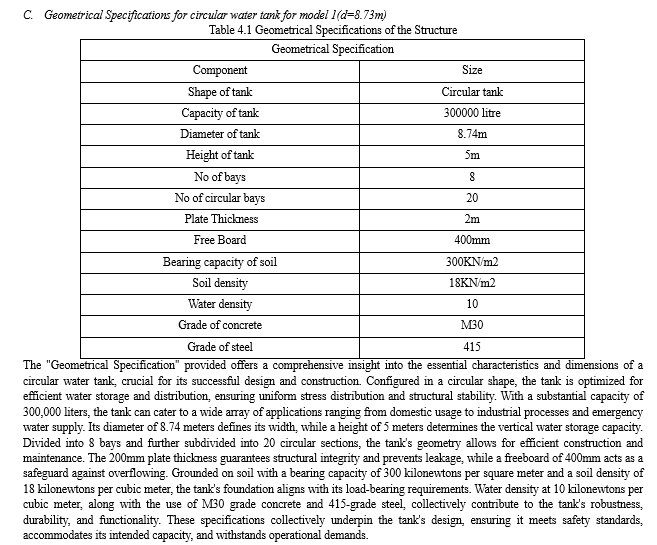
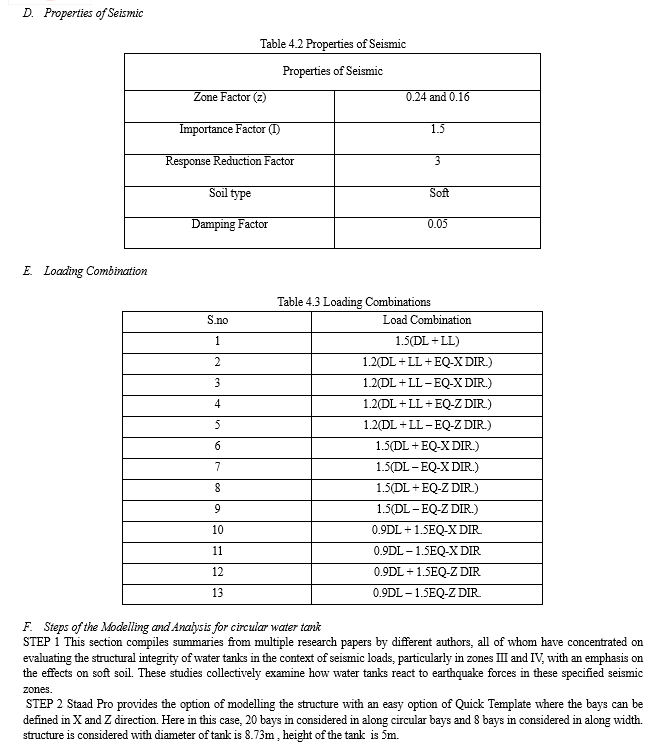
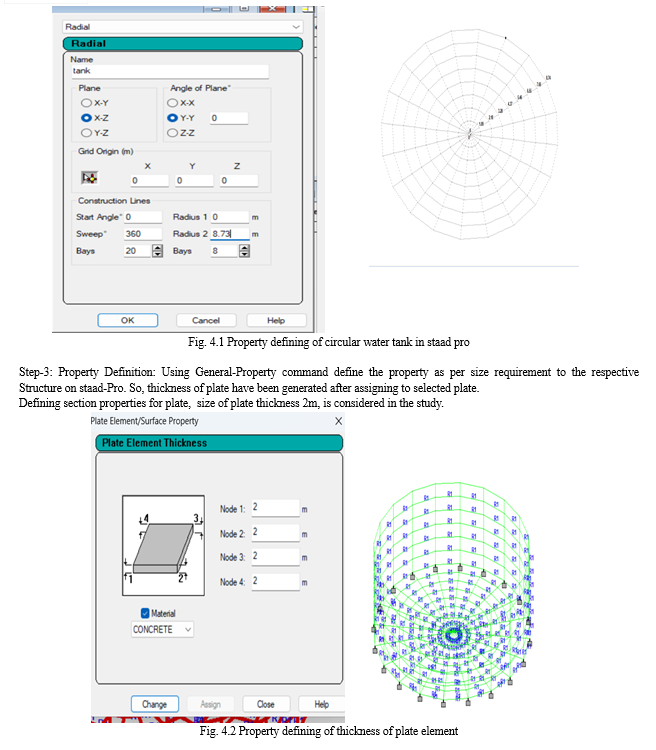
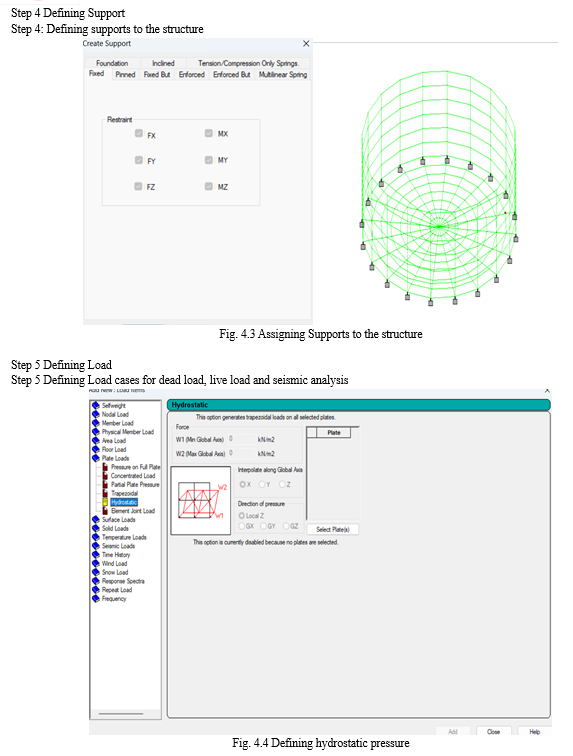

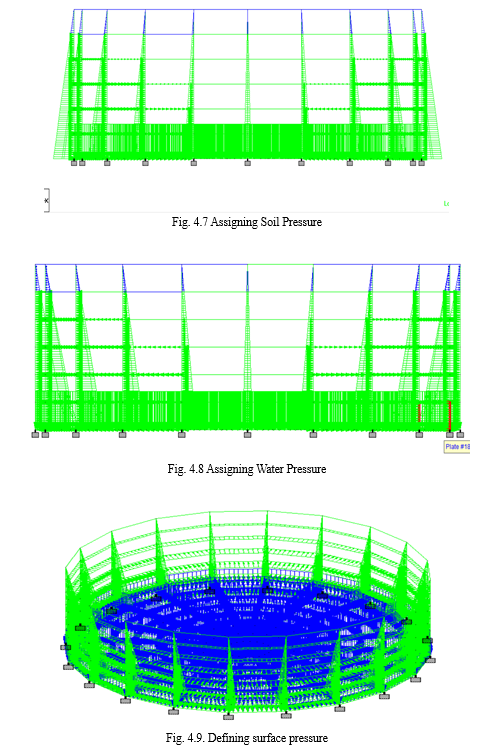
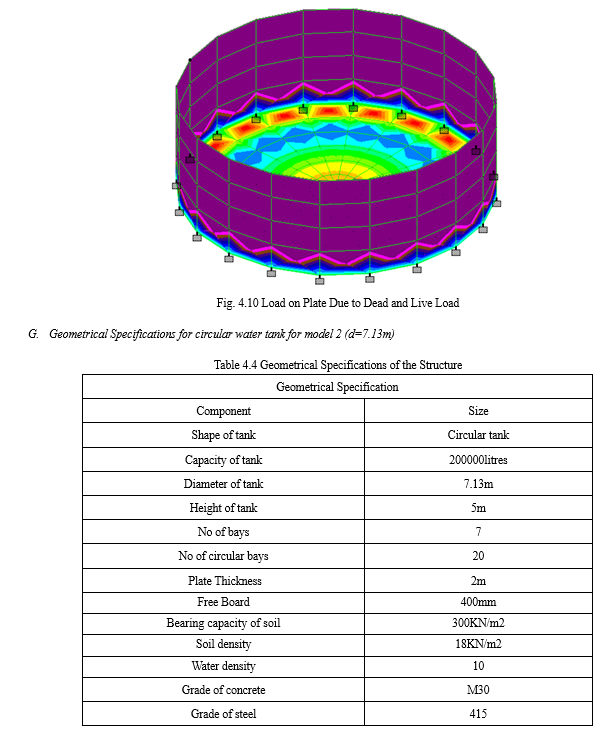
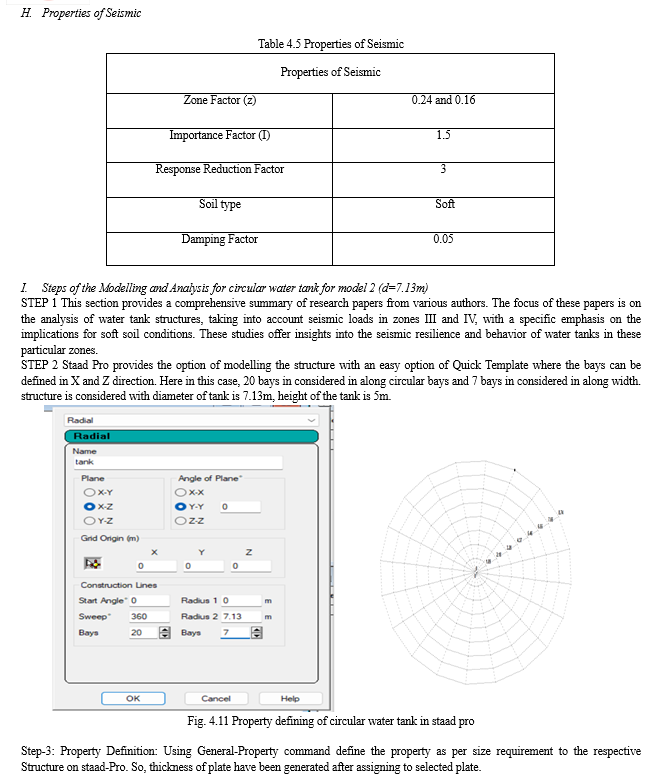
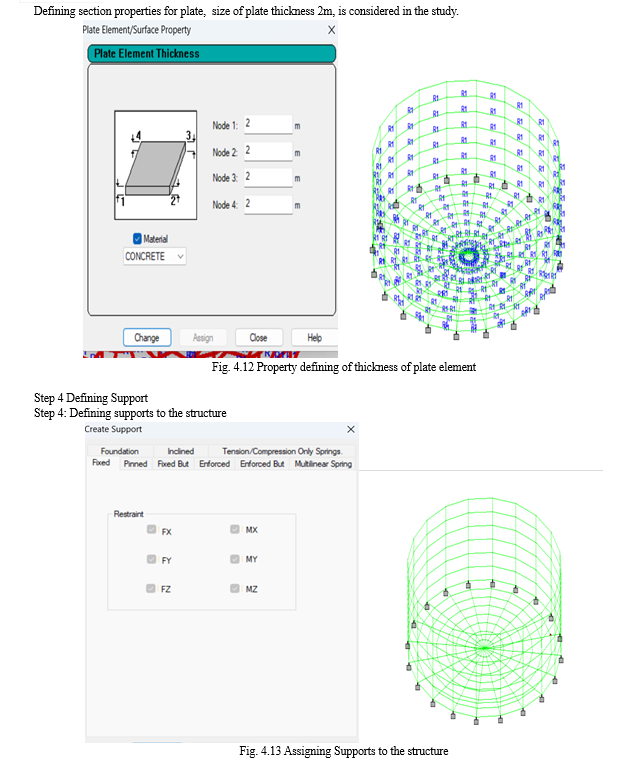
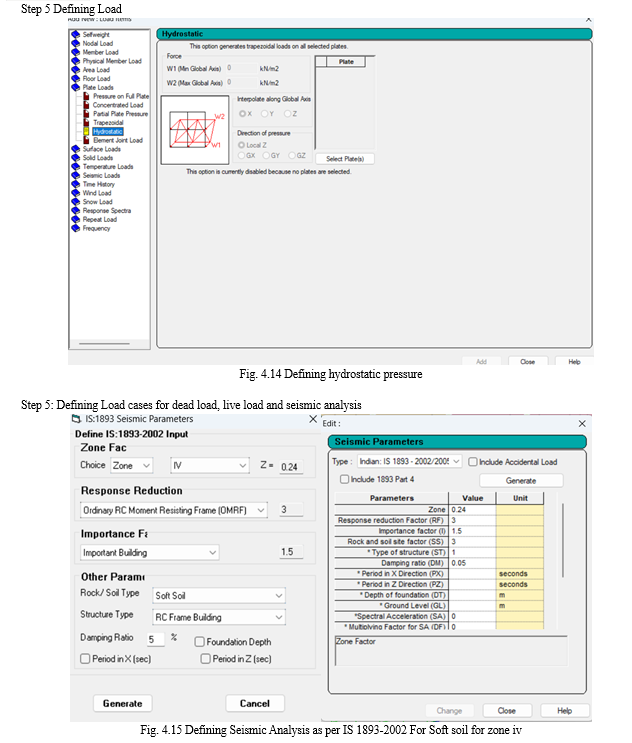

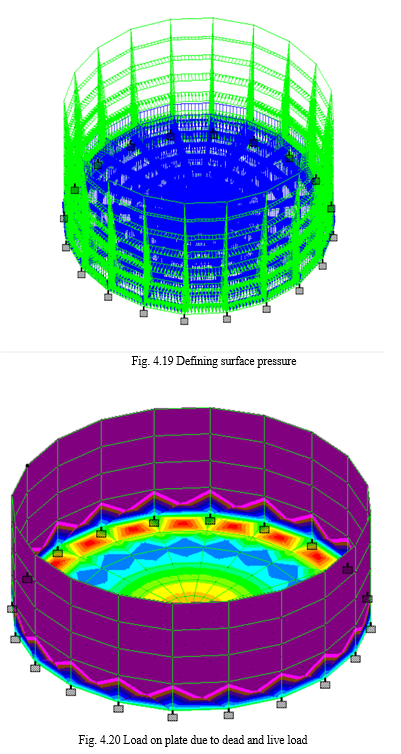
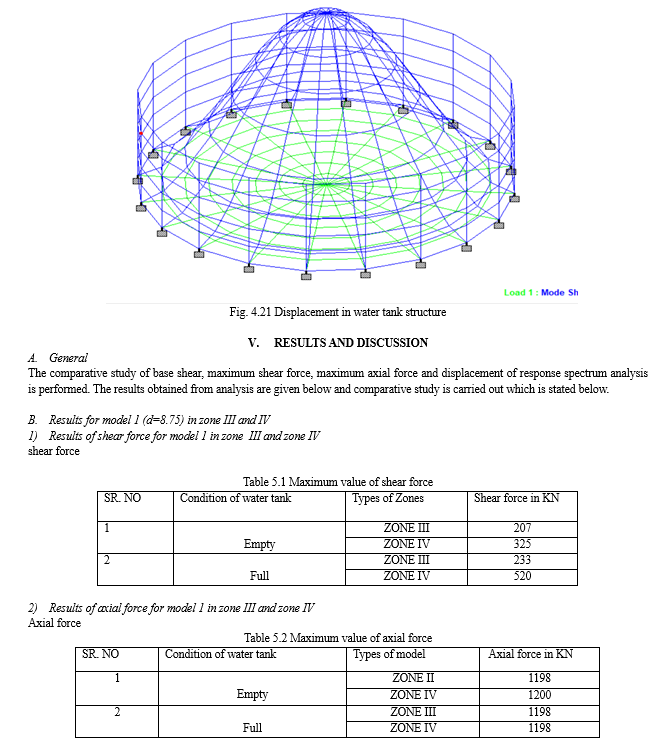

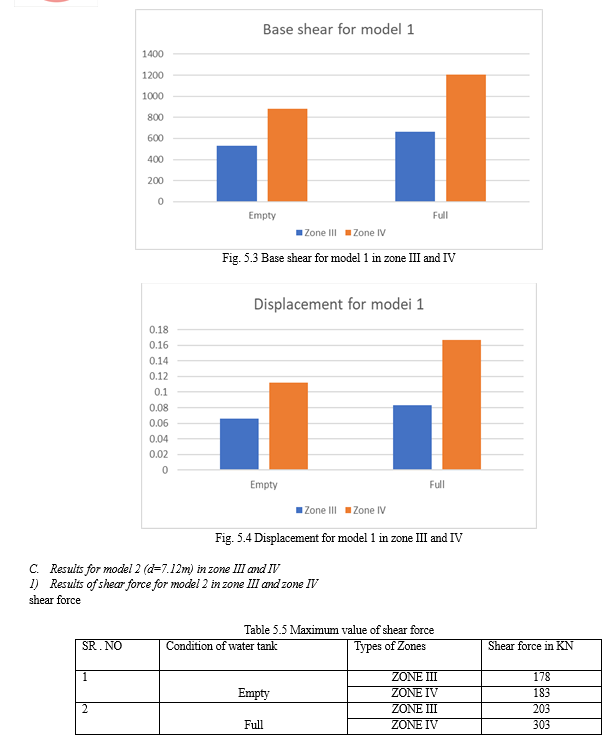
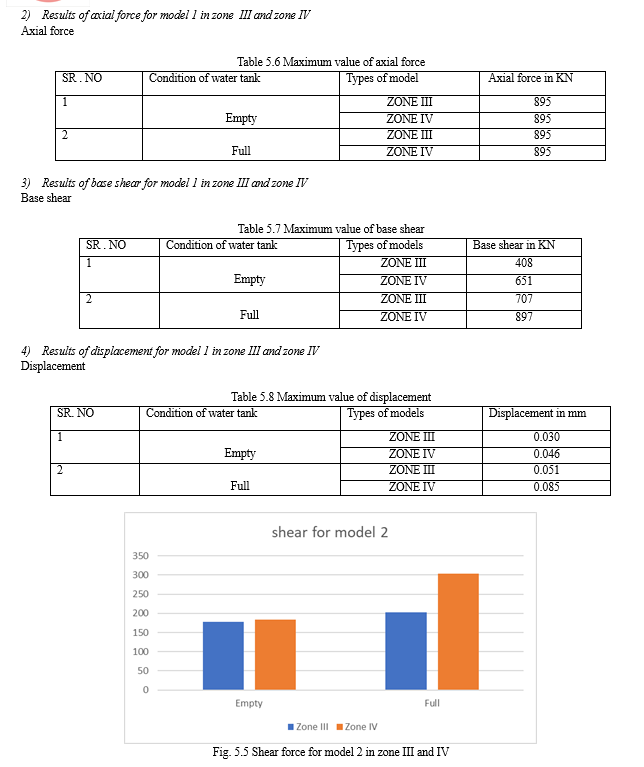
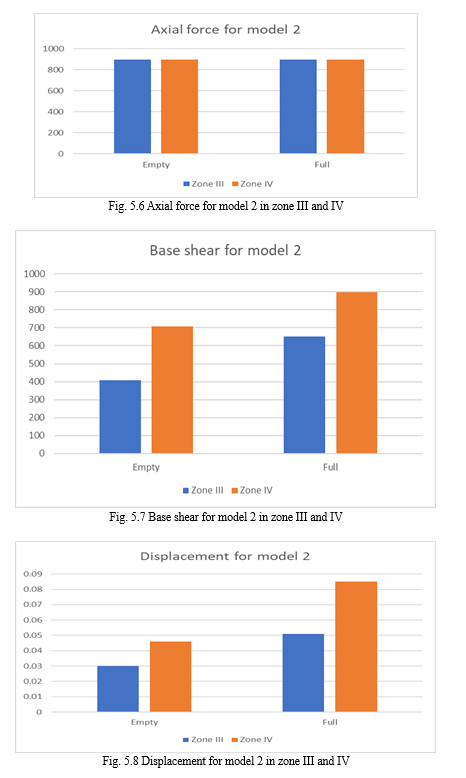
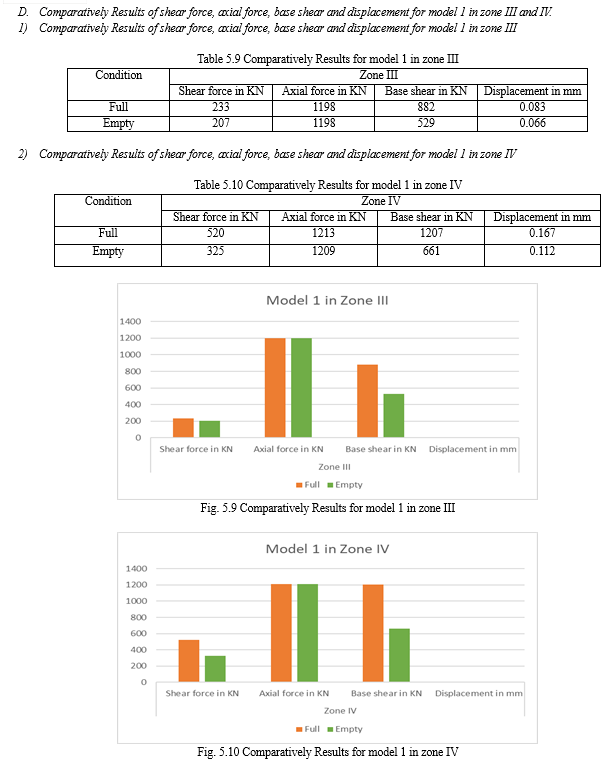
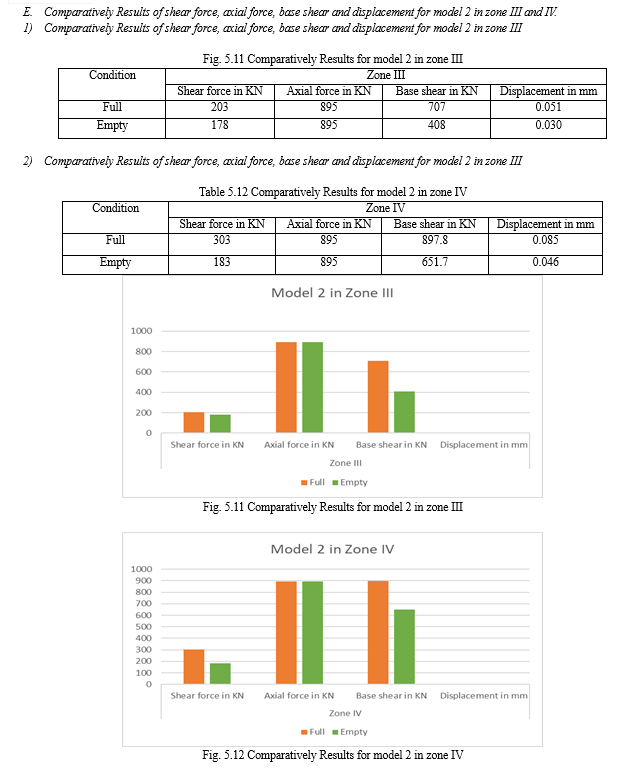
Conclusion
A. Conclusion The effect of seismic for circular underground water tank reinforced with various load, various zone. Variation in seismic responses of structure such as base shear, shear force, axial load and displacement were considered for the study. The results for different zone and different parameter in underground circular water tank are discuss in results section for the discussion it is concluded that. The following general conclusions were drawn from the present study. B. Comprehensively the zone effects on underground circular water tank. For model 1(d=8.73m) and model 2 (d=7.13m) considering variation in zone in presence seismic zone iii and iv. 1) Comprehensively the zone effects on underground circular water tank. For model 1(d=8.73m) in zone iii and iv Base shear • In case of model 1(d=8.73m) based on base shear of tank with is obtained as 529KN in empty condition and 882KN in full tank condition for zone III. When the zone change to IV base shear of tank is increased to 661 KN in empty condition and1207KN in full tank condition. • Max base shear in full tank condition in both zone iii and iv • Max base shear in zone iv as compared to that zone iii in both full and empty conditio Shear force • In case of model 1(d=8.73) based on shear force of tank with is obtained as 207KN in empty condition and 233KN in full tank condition for zone III. When the zone change to IV base shear of tank is increased to 325 KN in empty condition and 520 in full tank condition. • Max shear force in full tank condition in both zone iii and iv • Max shear force in zone iv as compared to that zone iii in both full and empty conditio Axial force • In case of model 1(d=8.73) based on axial force of tank with is obtained as 1198KN in empty condition and 1198KN in full tank condition for zone III. When the zone change to IV axial force of tank is same as 1198 KN in empty condition and 1200KN in full tank condition. • Max axial force same as in full tank and empty tank condition in both zone iii and iv • No effect on axial force of both condition full and empty and both zone iii and iv Displacement • In case of model 1(d=8.73) based on displacement of tank with is obtained as 0.066mm in empty condition and 0.083mm in full tank condition for zone III. When the zone change to IV displacement of tank is increased to 0.112 in empty condition and 0.167 in full tank condition. • Max displacement in full tank condition in both zone iii and iv • Max displacement in zone iv as compared to that zone iii in both full and empty condition 2) Comprehensively the zone effects on underground circular water tank. For model 2 (d=7.13m) in zone iii and iv Base shear • In case of model 1(d=8.73m) based on base shear of tank with is obtained as 408KN in empty condition and 707KN in full tank condition for zone III. When the zone change to IV base shear of tank is increased to 651 KN in empty condition and 897KN in full tank condition. • Max base shear in full tank condition in both zone iii and iv • Max base shear in zone iv as compared to that zone iii in both full and empty condition Shear force • In case of model 1(d=8.73) based on shear force of tank with is obtained as 178KN in empty condition and 203KN in full tank condition for zone III. When the zone change to IV base shear of tank is increased to 183 KN in empty condition and 303KN in full tank condition. • Max shear force in full tank condition in both zone iii and iv • Max shear force in zone iv as compared to that zone iii in both full and empty condition Axial force • In case of model 1(d=8.73) based on axial force of tank with is obtained as 895KN in empty condition and 895KN in full tank condition for zone III. When the zone change to IV axial force of tank is same as 895 KN in empty condition and 895KN in full tank condition. • Max axial force same as in full tank and empty tank condition in both zone iii and iv • No effect on axial force of both condition full and empty and both zone iii and iv Displacement • In case of model 1(d=8.73) based on displacement of tank with is obtained as 0.030mm in empty condition and 0.051mm in full tank condition for zone III. When the zone change to IV displacement of tank is increased to 0.046mm in empty condition and 0.085mm in full tank condition. • Max displacement in full tank condition in both zone iii and iv • Max displacement in zone iv as compared to that zone iii in both full and empty condition 3) Comprehensively the zone effects on underground circular water tank. For model 1(d=8.73m) in zone III and IV Table 6.1 Comprehensively zone results for model 1 in zone III and IV CONDISION MODEL I III IV Shear force in KN Axial force in KN Base shear in KN Displacement in mm Shear force in KN Axial force in KN Base shear in KN Displacement in mm Full 233 1198 882 0.083 520 1200 1207 0.167 Empty 207 1198 529 0.066 325 1198 661 0.112 4) Comprehensively the zone effects on underground circular water tank. For model 2 (d=7.13m) in zone III and IV Table 6.2 Comprehensively zone results for model 2 in zone III and IV CONDISION MODEL II III IV Shear force in KN Axial force in KN Base shear in KN Displacement in mm Shear force in KN Axial force in KN Base shear in KN Displacement in mm Full 203 895 707 0.051 303 895 897.8 0.085 Empty 178 895 408 0.030 183 895 651.7 0.046 C. Comprehensively the parametric effects on underground circular water tank. For mode 1(d=8.73m) and model 2 (d=7.13m) considering variation in parameter in presence seismic zone iii and iv. 1) Comprehensively the parametric effects on underground circular water tank. For model 1(d=8.73m) and model 2 (7.13) in zone iii. Base shear • In case of model 2 (d=7.13m) based on base shear of tank with is obtained as 408KN in empty condition and 707KN in full tank condition for zone III. When change to diameter (d=8.73m) base shear of tank is increased to 529 KN in empty condition and 882 KN in full tank condition. • Max base shear in full tank condition in both model • Max base shear in model 1(8.73) as compared to that model 2(7.13) zone iii in both full and empty condition Shear force • In case of model 2 (d=7.13m) based on shear force of tank with is obtained as 178KN in empty condition and 203KN in full tank condition for zone III. When change to diameter(d=8.73m) shear force of tank is increased to 207 KN in empty condition and 233 KN in full tank condition. • Max shear force in full tank condition in both model • Max shear force in model 1(d=8.73m) as compared to that model 2(d=7.13m) zone iii in both full and empty condition Axial force • In case of model 2 (d=7.13m) based on axial force of tank with is obtained as 895 in empty condition and 895 in full tank condition for zone III. When change to diameter(d=8.73m) axial force of tank is increased to 1198 KN in empty condition and 1198 KN in full tank condition • Max axial force in model 1 as compared to that model 2. • No effect on axial force of both condition full and empty. Displacement • In case of model 2 (d=7.13m) based on displacement of tank with is obtained as 0.030mm in empty condition and 0.051mm in full tank condition for zone III. When change to diameter(d=8.73m) shear force of tank is increased to 0.066mm in empty condition and 0.083 in full tank condition. • Max shear force in full tank condition in both model • Max shear force in model 1(d=8.73m) as compared to that model 2(d=7.13m) zone iii in both full and empty condition 2) Comprehensively the parametric effects on underground circular water tank. For model 1(d=8.73m) and model 2 (d=7.13m) in zone iv. Base shear • In case of model 2 (d=7.13m) based on base shear of tank with is obtained as 651KN in empty condition and 897KN in full tank condition for zone III. When change to diameter(d=8.73m) base shear of tank is increased to 661 KN in empty condition and 1207 KN in full tank condition. • Max base shear in full tank condition in both model • Max base shear in model 1(d=8.73m) as compared to that model 2(d=7.13m) zone iii in both full and empty condition Shear force • In case of model 2 (d=7.13m) based on shear force of tank with is obtained as 183KN in empty condition and 303KN in full tank condition for zone III. When change to diameter(d=8.73m) shear force of tank is increased to 325 KN in empty condition and 520 KN in full tank condition. • Max shear force in full tank condition in both model • Max shear force in model 1(d=8.73m) as compared to that model 2(d=7.13m) zone iii in both full and empty condition Axial force • In case of model 2 (d=7.13m) based on axial force of tank with is obtained as 895 in empty condition and 895 in full tank condition for zone III. When change to diameter(d=8.73m) axial force of tank is increased to 1198 KN in empty condition and 1198 KN in full tank condition • Max axial force in model 1 as compared to that model 2. • No effect on axial force of both condition full and empty. Displacement • In case of model 2 (d=7.13m) based on displacement of tank with is obtained as 0.046mm in empty condition and 0.085mm in full tank condition for zone III. When change to diameter(d=8.73m) shear force of tank is increased to 0.112mm in empty condition and 0.167 in full tank condition. • Max shear force in full tank condition in both model • Max shear force in model 1(8.73) as compared to that model 2(7.13) zone iii in both full and empty condition D. Comprehensively the parametric effects on underground circular water tank. For model 1(d=8.73m) and model 2 (7.13) in zone iii. Table 6.3 Comprehensively parametric results for model 1 and model 2 in zone III CONDISION Zone III Model 1 Model 2 Shear force in KN Axial force in KN Base shear in KN Displacement in mm Shear force in KN Axial force in KN Base shear in KN Displacement in mm Full 233 1198 882 0.083 203 895 707 0.051 Empty 207 1198 529 0.066 178 895 408 0.030 1) Comprehensively the parametric effects on underground circular water tank. For model 1(d=8.73m) and model 2 (7.13) in zone iv. Table 6.4 Comprehensively parametric results for model 1 and model 2 in zone IV CONDISION Zone IV Model 1 Model 2 Shear force in KN Axial force in KN Base shear in KN Displacement in mm Shear force in KN Axial force in KN Base shear in KN Displacement in mm Full 520 1200 1207 0.167 303 895 897.8 0.085 Empty 325 1198 661 0.112 183 895 651.7 0.046 References Code S NO CODE REFERENCES 1 IS 1893-2000/2005 Indian Standard for Earthquake Resistant Design 2 IS 456-2000 Indian Standard For plain and Reinforced Concrete 3 IS 875(Part 1, Part 2) Indian Standard for Loads for Building and structure 4 IS 3370-2009 Indian Standard for water tank Design E. Future Scope The future scope of seismic analysis in civil engineering includes improving soil characterization through extensive site investigations, laboratory testing, and remote sensing methods. Developing advanced analysis methods to better simulate the dynamic behaviour of soil-structure systems, including refining response spectrum methods and incorporating accurate soil-structure interaction models, is another focus. Incorporating risk and reliability analysis by considering uncertainties in soil properties, structural parameters, and seismic hazard assessments is essential. Additionally, future research can concentrate on developing innovative and cost-effective seismic retrofitting techniques for RC structures, evaluating the effectiveness of various
References
[1] Yang, Z., Chen, H., Wang, L., Sheng, Y., & Wang, Y. (2016). Comparative study of the influences of different water tank shapes on thermal energy storage capacity and thermal stratification. Renewable Energy, 85, 31-44. [2] Kabeel, A. E., El-Maghlany, W. M., Abdelgaied, M., & Abdel-Aziz, M. M. (2020). Performance enhancement of pyramid-shaped solar stills using hollow circular fins and phase change materials. Journal of Energy Storage, 31, 101610. [3] Huang, H., Xiao, Y., Lin, J., Zhou, T., Liu, Y., & Zhao, Q. (2020). Improvement of the efficiency of solar thermal energy storage systems by cascading a PCM unit with a water tank. Journal of cleaner production, 245, 118864. [4] Dahash, A., Ochs, F., & Tosatto, A. (2020). Advances in modeling and evaluation of large-scale hot water tanks and pits in renewable-based district heating. In Proceedings of 13th International Conference on Solar Energy for Buildings and Industry (EuroSun 2020). [5] Abdelsalam, M. Y., Teamah, H. M., Lightstone, M. F., & Cotton, J. S. (2020). Hybrid thermal energy storage with phase change materials for solar domestic hot water applications: Direct versus indirect heat exchange systems. Renewable Energy, 147, 77-88. [6] Summerfelt, S. T., Mathisen, F., Holan, A. B., & Terjesen, B. F. (2016). Survey of large circular and octagonal tanks operated at Norwegian commercial smolt and post-smolt sites. Aquacultural engineering, 74, 105-110. [7] Shan, M., Yu, T. H., & Yang, X. (2016). Assessment of an integrated active solar and air-source heat pump water heating system operated within a passive house in a cold climate zone. Renewable energy, 87, 1059-1066. [8] Makropoulos, C., Rozos, E., Tsoukalas, I., Plevri, A., Karakatsanis, G., Karagiannidis, L., ... & Lytras, E. (2018). Sewer-mining: A water reuse option supporting circular economy, public service provision and entrepreneurship. Journal of environmental management, 216, 285-298. [9] Shubhangi, K., & Shireesh, D. (2015). Water-Related Architecture as an Identity Anchor of Chanderi-Madhya Pradesh, India. Bonfring International Journal of Industrial Engineering and Management Science, 5(2), 29. [10] Yuk, H., Lin, S., Ma, C., Takaffoli, M., Fang, N. X., & Zhao, X. (2017). Hydraulic hydrogel actuators and robots optically and sonically camouflaged in water. Nature communications, 8(1), 14230. [11] He, W., Hong, X., Zhao, X., Zhang, X., Shen, J., & Ji, J. (2015). Operational performance of a novel heat pump assisted solar façade loop-heat-pipe water heating system. Applied energy, 146, 371-382. [12] He, Z., Fang, X., Zhang, Z., & Gao, X. (2016). Numerical investigation on performance comparison of non-Newtonian fluid flow in vertical heat exchangers combined helical baffle with elliptic and circular tubes. Applied Thermal Engineering, 100, 84-97. [13] Yan, J., Bi, Q., Liu, Z., Zhu, G., & Cai, L. (2015). Subcooled flow boiling heat transfer of water in a circular tube under high heat fluxes and high mass fluxes. Fusion Engineering and Design, 100, 406-418. [14] New, T. H., & Long, J. (2015). Dynamics of laminar circular jet impingement upon convex cylinders. Physics of Fluids, 27(2). [15] Plew, D. R., Klebert, P., Rosten, T. W., Aspaas, S., & Birkevold, J. (2015). Changes to flow and turbulence caused by different concentrations of fish in a circular tank. Journal of Hydraulic Research, 53(3), 364-383. [16] Arunkumar, T., & Kabeel, A. E. (2017). Effect of phase change material on concentric circular tubular solar still-Integration meets enhancement. Desalination, 414, 46-50. [17] Bhadouriya, R., Agrawal, A., & Prabhu, S. V. (2015). Experimental and numerical study of fluid flow and heat transfer in an annulus of inner twisted square duct and outer circular pipe. International Journal of Thermal Sciences, 94, 96-109. [18] Abdelgaied, M., Zakaria, Y., Kabeel, A. E., & Essa, F. A. (2021). Improving the tubular solar still performance using square and circular hollow fins with phase change materials. Journal of Energy Storage, 38, 102564. [19] White, S. C., Krebs, E., Huysman, N., Voorhees, J. M., & Barnes, M. E. (2019). Use of suspended plastic conduit arrays during brown trout and rainbow trout rearing in circular tanks. North American Journal of Aquaculture, 81(1), 101-106. [20] Bouhal, T., Fertahi, S., Agrouaz, Y., El Rhafiki, T., Kousksou, T., & Jamil, A. (2017). Numerical modeling and optimization of thermal stratification in solar hot water storage tanks for domestic applications: CFD study. Solar Energy, 157, 441-455. [21] Rizzo, S., Cappellaro, F., Accorsi, M., Orsini, F., Gianquinto, G., & Bonoli, A. (2017). Co-design for a circular approach in green technologies: adaptation of reused building material as growing substrate for soilless cultivation of lettuce (Lactuca sativa var. capitata). Environmental Engineering & Management Journal (EEMJ), 16(8). [22] Wei, Z., & Hu, C. (2015). Experimental study on water entry of circular cylinders with inclined angles. Journal of Marine Science and Technology, 20, 722-738. [23] Gorle, J. M. R., Terjesen, B. F., Mota, V. C., & Summerfelt, S. (2018). Water velocity in commercial RAS culture tanks for Atlantic salmon smolt production. Aquacultural engineering, 81, 89-100. [24] Shi, Q., Wang, H., Wu, H., & Lee, C. (2017). Self-powered triboelectric nanogenerator buoy ball for applications ranging from environment monitoring to water wave energy farm. Nano Energy, 40, 203-213. [25] Vashistha, C., Patil, A. K., & Kumar, M. (2016). Experimental investigation of heat transfer and pressure drop in a circular tube with multiple inserts. Applied Thermal Engineering, 96, 117-129. [26] Modak, M., Chougule, S. S., & Sahu, S. K. (2018). An experimental investigation on heat transfer characteristics of hot surface by using CuO–water nanofluids in circular jet impingement cooling. Journal of Heat Transfer, 140(1), 012401. [27] Morgan, R., Nelmes, S., Gibson, E., & Brett, G. (2015). Liquid air energy storage–analysis and first results from a pilot scale demonstration plant. Applied energy, 137, 845-853. [28] Jian, S., Zhao, C., Fang, S., & Yu, K. (2015). Effects of different vegetation restoration on soil water storage and water balance in the Chinese Loess Plateau. Agricultural and Forest Meteorology, 206, 85-96. [29] Sharma, N., Kalbar, P. P., & Salman, M. (2022). Global review of circular economy and life cycle thinking in building Demolition Waste Management: A way ahead for India. Building and Environment, 222, 109413. [30] Fuentes, E., Arce, L., & Salom, J. (2018). A review of domestic hot water consumption profiles for application in systems and buildings energy performance analysis. Renewable and Sustainable Energy Reviews, 81, 1530-1547. [31] Fatimah, Y. A., Govindan, K., Murniningsih, R., & Setiawan, A. (2020). Industry 4.0 based sustainable circular economy approach for smart waste management system to achieve sustainable development goals: A case study of Indonesia. Journal of Cleaner Production, 269, 122263.
Copyright
Copyright © 2024 Sushil Shah. This is an open access article distributed under the Creative Commons Attribution License, which permits unrestricted use, distribution, and reproduction in any medium, provided the original work is properly cited.

Download Paper
Paper Id : IJRASET62980
Publish Date : 2024-05-30
ISSN : 2321-9653
Publisher Name : IJRASET
DOI Link : Click Here
 Submit Paper Online
Submit Paper Online

